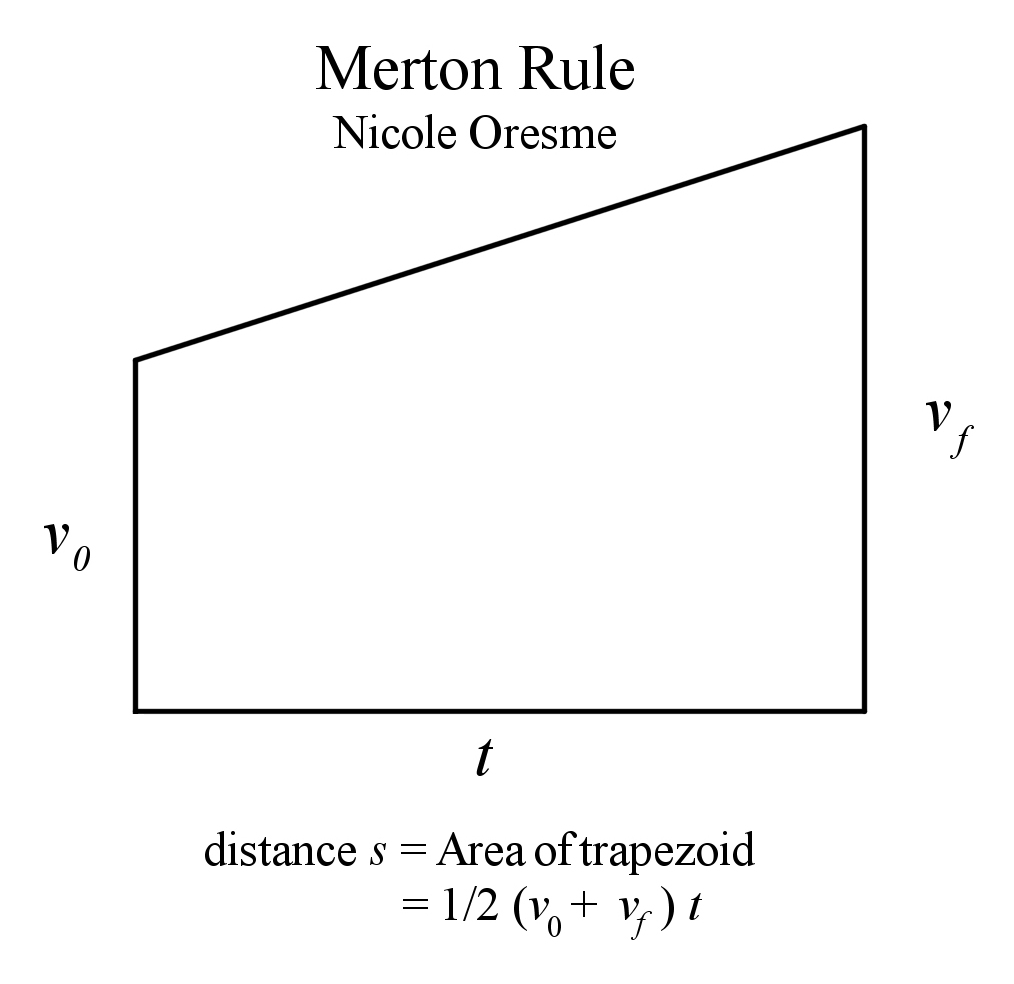Mean speed theorem on:
[Wikipedia]
[Google]
[Amazon]

 The mean speed theorem, also known as the Merton rule of uniform acceleration, was discovered in the 14th century by the
The mean speed theorem, also known as the Merton rule of uniform acceleration, was discovered in the 14th century by the
William Heytesbury
, in ''The Stanford Encyclopedia of Philosophy''. History of philosophy Merton College, Oxford History of the University of Oxford 14th century in science Classical mechanics

 The mean speed theorem, also known as the Merton rule of uniform acceleration, was discovered in the 14th century by the
The mean speed theorem, also known as the Merton rule of uniform acceleration, was discovered in the 14th century by the Oxford Calculators
The Oxford Calculators were a group of 14th-century thinkers, almost all associated with Merton College, Oxford; for this reason they were dubbed "The Merton School". These men took a strikingly logical and mathematical approach to philosoph ...
of Merton College
Merton College (in full: The House or College of Scholars of Merton in the University of Oxford) is one of the constituent colleges of the University of Oxford in England. Its foundation can be traced back to the 1260s when Walter de Merton, ...
, and was proved by Nicole Oresme
Nicole Oresme (; c. 1320–1325 – 11 July 1382), also known as Nicolas Oresme, Nicholas Oresme, or Nicolas d'Oresme, was a French philosopher of the later Middle Ages. He wrote influential works on economics, mathematics, physics, astrology an ...
. It states that a uniformly accelerated body (starting from rest, i.e. zero initial velocity) travels the same distance as a body with uniform speed whose speed is half the final velocity of the accelerated body.
Details
Oresme provided a geometrical verification for the generalized Merton rule, which we would express today as (i.e., distance traveled is equal to one half of the sum of the initial and final velocities, multiplied by the elapsed time ), by finding the area of atrapezoid
A quadrilateral with at least one pair of parallel sides is called a trapezoid () in American and Canadian English. In British and other forms of English, it is called a trapezium ().
A trapezoid is necessarily a convex quadrilateral in Eu ...
. Clay tablets used in Babylonian astronomy
Babylonian astronomy was the study or recording of celestial objects during the early history of Mesopotamia.
Babylonian astronomy seemed to have focused on a select group of stars and constellations known as Ziqpu stars. These constellation ...
(350–50 BC) present trapezoid procedures for computing Jupiter's position and motion
In physics, motion is the phenomenon in which an object changes its position with respect to time. Motion is mathematically described in terms of displacement, distance, velocity, acceleration, speed and frame of reference to an observer and m ...
and anticipate the theorem by 14 centuries.
The medieval scientists demonstrated this theorem—the foundation of " the law of falling bodies"—long before Galileo
Galileo di Vincenzo Bonaiuti de' Galilei (15 February 1564 – 8 January 1642) was an Italian astronomer, physicist and engineer, sometimes described as a polymath. Commonly referred to as Galileo, his name was pronounced (, ). He was ...
, who is generally credited with it. Oresme's proof is also the first known example of the modelization of a physical problem as a mathematical function with a graphical representation, as well as of an early form of integration, thus laying the foundation of calculus
Calculus, originally called infinitesimal calculus or "the calculus of infinitesimals", is the mathematics, mathematical study of continuous change, in the same way that geometry is the study of shape, and algebra is the study of generalizati ...
. The mathematical physicist and historian of science Clifford Truesdell
Clifford Ambrose Truesdell III (February 18, 1919 – January 14, 2000) was an American mathematician, natural philosopher, and historian of science.
Life
Truesdell was born in Los Angeles, California. After high school, he spent two years in E ...
, wrote:Clifford Truesdell, ''Essays in The History of Mechanics'', (Springer-Verlag, New York, 1968), p. 30
The theorem is a special case of the more general kinematics equations for uniform acceleration.
See also
*Science in the Middle Ages
The history of science covers the development of science from ancient times to the present. It encompasses all three major branches of science: natural, social, and formal.
Science's earliest roots can be traced to Ancient Egypt and Meso ...
* Scholasticism
Scholasticism was a medieval school of philosophy that employed a critical organic method of philosophical analysis predicated upon the Aristotelian 10 Categories. Christian scholasticism emerged within the monastic schools that translat ...
Notes
{{ReflistFurther reading
* Sylla, Edith (1982) "The Oxford Calculators", in Kretzmann, Kenny & Pinborg (edd.), ''The Cambridge History of Later Medieval Philosophy''. * Longeway, John (2003)William Heytesbury
, in ''The Stanford Encyclopedia of Philosophy''. History of philosophy Merton College, Oxford History of the University of Oxford 14th century in science Classical mechanics